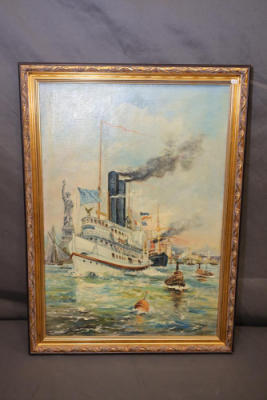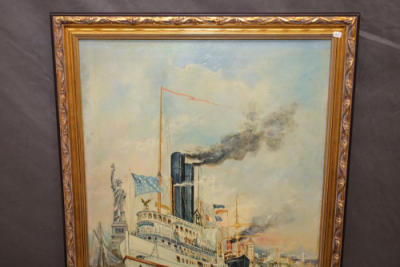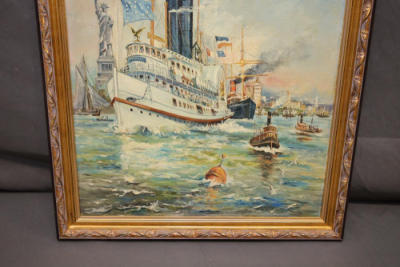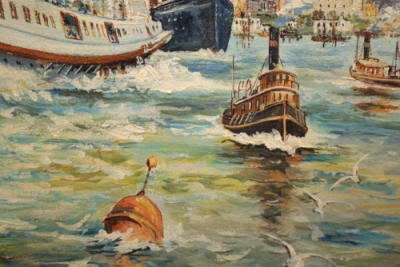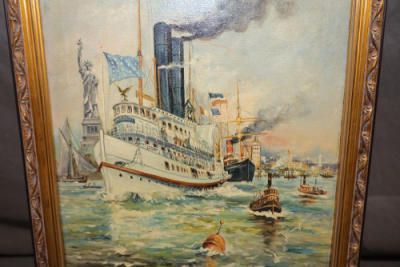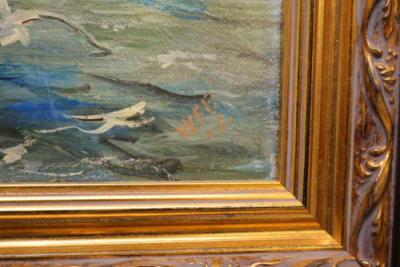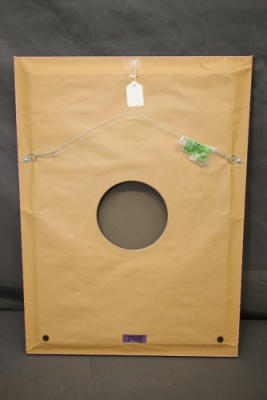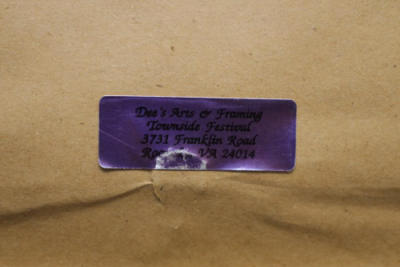This curated auction of Hudson River Paintings for sale is from the personal collection of Robert & Susan Doyle of Fishkill, NY. The Doyle's are offering thirty-seven American 19thC Hudson River School paintings at auction. All Hudson River paintings in this sale are original works and almost all have been professionally cleaned and conserved. The first American School of Art is known as "The Hudson River School," consisting of mid nineteenth century "Nature Painters" who found spirituality in nature. These adventuresome Hudson River artists hiked to see impressive views. They sketched and did studies in the field to bring back to their studios to create finished paintings. The Hudson River served as the main route of travel to the best places, as well as provided the best subject matter. New York City, with the National Academy of Design to exhibit at, was the center of the American Arts world in the 19thC. These "Nature Painters" celebrated and depicted the pristine magnificence of the American landscape of the 19th Century on their canvases. Now you can experience the beauty, tranquility and grandness of Nature from the first American School of Art; the Hudson River School. Register and Bid now! Artwork is on display at the Absolute Auction Center in Pleasant Valley, NY.
Payment is due by Friday, December 13 at 1PM. All lots subject to seller approval.
Information with payment and pickup instructions will be emailed to winning bidders the morning after the auction ends.
Pickup is by appointment only and must be completed by Friday, December 13 at 3PM.
All lots sold as is, where is. There is a 18% Buyers Premium for all lots purchased. Payment methods for non-vehicle & non-equipment is cash, Visa, Master Card or Discover card.
Preview available online 24 hours or by appointment only. To schedule, contact our office at 845-635-3169, option 7.
Items are located at the Absolute Auction Center: 45 South Ave, Pleasant Valley, NY 12569.
Click More Info/Bid Now for additional photos.
Payment is due by Friday, December 13 at 1PM. All lots subject to seller approval.
Information with payment and pickup instructions will be emailed to winning bidders the morning after the auction ends.
Pickup is by appointment only and must be completed by Friday, December 13 at 3PM.
All lots sold as is, where is. There is a 18% Buyers Premium for all lots purchased. Payment methods for non-vehicle & non-equipment is cash, Visa, Master Card or Discover card.
Preview available online 24 hours or by appointment only. To schedule, contact our office at 845-635-3169, option 7.
Items are located at the Absolute Auction Center: 45 South Ave, Pleasant Valley, NY 12569.
Click More Info/Bid Now for additional photos.
Auction Info
This curated auction of Hudson River Paintings for sale is from the personal collection of Robert & Susan Doyle of Fishkill, NY. The Doyle's are offering thirty-seven American 19thC Hudson River School paintings at auction. All Hudson River paintings in this sale are original works and almost all have been professionally cleaned and conserved. The first American School of Art is known as "The Hudson River School," consisting of mid nineteenth century "Nature Painters" who found spirituality in nature. These adventuresome Hudson River artists hiked to see impressive views. They sketched and did studies in the field to bring back to their studios to create finished paintings. The Hudson River served as the main route of travel to the best places, as well as provided the best subject matter. New York City, with the National Academy of Design to exhibit at, was the center of the American Arts world in the 19thC. These "Nature Painters" celebrated and depicted the pristine magnificence of the American landscape of the 19th Century on their canvases. Now you can experience the beauty, tranquility and grandness of Nature from the first American School of Art; the Hudson River School. Register and Bid now! Artwork is on display at the Absolute Auction Center in Pleasant Valley, NY.
Payment is due by Friday, December 13 at 1PM. All lots subject to seller approval.
Information with payment and pickup instructions will be emailed to winning bidders the morning after the auction ends.
Pickup is by appointment only and must be completed by Friday, December 13 at 3PM.
All lots sold as is, where is. There is a 18% Buyers Premium for all lots purchased. Payment methods for non-vehicle & non-equipment is cash, Visa, Master Card or Discover card.
Preview available online 24 hours or by appointment only. To schedule, contact our office at 845-635-3169, option 7.
Items are located at the Absolute Auction Center: 45 South Ave, Pleasant Valley, NY 12569.
Click More Info/Bid Now for additional photos.
Payment is due by Friday, December 13 at 1PM. All lots subject to seller approval.
Information with payment and pickup instructions will be emailed to winning bidders the morning after the auction ends.
Pickup is by appointment only and must be completed by Friday, December 13 at 3PM.
All lots sold as is, where is. There is a 18% Buyers Premium for all lots purchased. Payment methods for non-vehicle & non-equipment is cash, Visa, Master Card or Discover card.
Preview available online 24 hours or by appointment only. To schedule, contact our office at 845-635-3169, option 7.
Items are located at the Absolute Auction Center: 45 South Ave, Pleasant Valley, NY 12569.
Click More Info/Bid Now for additional photos.
Categories:
William Frederick Paskell (1866-1951) “Pilgrim Steamship” in New York Harbor. 1906. Framed, signed, detailed oil on canvas of the Pilgrim Steamship that travelled between New York City and Boston. The Pilgrim Steamship was the “largest in the World,” at the time, part of the Fall River Line. https://en.wikipedia.org/wiki/Fall_River_Line AskArt Bio: William F. Paskell was born in London and moved to Boston in 1872 as a youngster with his family. By the age of twenty-one he was already mentioned in the press as a very promising artist, with his paintings hanging beside the work of Childe Hassam and John J. Enneking in the annual Boston Art Club exhibitions. Paskell married in 1900 and by 1905. he had four children. Paskell started painting a fairly tight style of Impressionism and gradually reached a loose Impressionistic style before World War I. Paskell painted up to the day of his death, dying in Boston in 1951 at the age of eighty-five, in humble circumstances. He is considered one of the last "White Mountain School of Painters" with a connection to the 19th century. He painted both with watercolors and oils. His paintings exhibited at the Boston Art Club include CHOCORUA MOUNTAIN -- TAMWORTH, N.H.; THE BRIDGE AT WONALACET, N.H.; and THE SUMMIT OF MT. CHOCORUA. Source: Charles Vogel. More info from Mom: "My son was born with a pencil in his hand." Thus spoke William F. Paskell's mother, many times and with great pride. He was born in London in 1866. In 1872 the family came to Boston and settled in the Mission Hill area of Roxbury. Paskell's father, William E., came from a long line of cabinet-makers, framers, gilders, and artists. It is no surprise that he promptly found a job on Bromfield Street in the art district, making picture frames for all the local artists. By the time young William reached high school, he had been sketching prolifically. He took public streetcars to the end of the line and sketched the suburbs where he yearned to live. His father deemed him ready to help in the frame shop after school. The budding artist was all too glad to help. Sure enough, his first job was to deliver finished frames to the artists who had studios in the neighborhood. Paskell's favorite artist was Benjamin Champney. He admired his work and he loved visiting him, but he privately thought that he was too "old fashioned." Paskell thought that 19th century oils were drawings filled with paint. He believed he should paint directly on the canvas without drawing first. He was however intrigued by the subject matter of Champney's landscapes, the White Mountains that "Old Ben" (age 65) highly recommended. Paskell's father hung the boy's pencil drawings in the frame shop. They readily sold (unframed) for about 50 cents apiece. Some of them were minor masterpieces, especially for a boy age 14. William then knew that his chosen profession had arrived. He was in love with landscape painting. It must have been in his genes. By the time he graduated high school, he had taken oil painting lessons with a Boston painter, Francois de Blois, then age 50, who had taken a liking to him. The lessons were expensive, 50 cents an hour, but Paskell sold enough drawing and paintings to pay for his tuition. Deblois was an accomplished artist, a recognized member of the Boston Art Club whose style was halfway between tight realism and loose impressionism. While Deblois was his major teacher, he did take some lessons with a variety of painters who happened into his father's shop. Charles Sanderson gave him some lessons in watercolors. In 1884, at the tender age of 17, the jury of the Boston Art Club accepted his paintings. The following year the Boston Museum of Fine Arts exhibited one of his works. His youthful talent attracted publicity in the press. One reviewer called him the "boy genius of Boston Art." At one of the exhibitions John J. Enneking, one of Boston's great impressionist painters, came up to him and offered to critique his paintings. Paskell was thrilled to think that he deserved attention from what he called the "Old Master of Boston." He had been submitting sunset scenes to the art world. He wrote in his diary, "I am going to visit the old man, but I am not going to change." Sure enough, Enneking suggested that he paint lighter and brighter pictures. He followed Enneking's advice, and gradually painted lighter and brighter pictures. Then he heard about Mount Chocorua. For years he went to Tamworth and rented a room every September at the Wonalancet Inn, trading pictures for board and room. Of course he wandered into North Conway to see Champney's White Mountains. He took side trips to Laconia to see the beauty he had heard about in that area. He married in 1901 at the age of 34. In six years he had six children. Two died very young, four survived very well. Now he had a financial problem. In his old age, he told his granddaughter that he dealt with that challenge by serving two masters. He would produce "art for art's sake" some days, and he would produce "art for commerce" when he had to put bread on the table. During the Great Depression he also painted under the name of T. Bailey and H.H. Howe in order to have three chances to attract customers in art galleries. Although his first love was the mountains, he estimated that he had also painted about 1,000 harbor and marine scenes that people loved. Many of his works have been lost or whereabouts are unknown. Late in life, he once reflected, "I will be known for my watercolors." Perhaps only time will tell. In 1951, at the age of 84, he died in his studio (on the fourth floor of a building on LaGrange Street in back of the Touraine Hotel in Boston, preparing some drawings for Clorin's Gallery across the street) "with pencil in his hand." Sight: 21.5x15, Overall: 24.5x18. Auction Record: $4,100. Estimate: $3,000-$5,000,(See multiple photos for details and condition.)
More Details
William Frederick Paskell (1866-1951) “Pilgrim Steamship” in New York Harbor. 1906. Framed, signed, detailed oil on canvas of the Pilgrim Steamship that travelled between New York City and Boston. The Pilgrim Steamship was the “largest in the World,” at the time, part of the Fall River Line. https://en.wikipedia.org/wiki/Fall_River_Line AskArt Bio: William F. Paskell was born in London and moved to Boston in 1872 as a youngster with his family. By the age of twenty-one he was already mentioned in the press as a very promising artist, with his paintings hanging beside the work of Childe Hassam and John J. Enneking in the annual Boston Art Club exhibitions. Paskell married in 1900 and by 1905. he had four children. Paskell started painting a fairly tight style of Impressionism and gradually reached a loose Impressionistic style before World War I. Paskell painted up to the day of his death, dying in Boston in 1951 at the age of eighty-five, in humble circumstances. He is considered one of the last "White Mountain School of Painters" with a connection to the 19th century. He painted both with watercolors and oils. His paintings exhibited at the Boston Art Club include CHOCORUA MOUNTAIN -- TAMWORTH, N.H.; THE BRIDGE AT WONALACET, N.H.; and THE SUMMIT OF MT. CHOCORUA. Source: Charles Vogel. More info from Mom: "My son was born with a pencil in his hand." Thus spoke William F. Paskell's mother, many times and with great pride. He was born in London in 1866. In 1872 the family came to Boston and settled in the Mission Hill area of Roxbury. Paskell's father, William E., came from a long line of cabinet-makers, framers, gilders, and artists. It is no surprise that he promptly found a job on Bromfield Street in the art district, making picture frames for all the local artists. By the time young William reached high school, he had been sketching prolifically. He took public streetcars to the end of the line and sketched the suburbs where he yearned to live. His father deemed him ready to help in the frame shop after school. The budding artist was all too glad to help. Sure enough, his first job was to deliver finished frames to the artists who had studios in the neighborhood. Paskell's favorite artist was Benjamin Champney. He admired his work and he loved visiting him, but he privately thought that he was too "old fashioned." Paskell thought that 19th century oils were drawings filled with paint. He believed he should paint directly on the canvas without drawing first. He was however intrigued by the subject matter of Champney's landscapes, the White Mountains that "Old Ben" (age 65) highly recommended. Paskell's father hung the boy's pencil drawings in the frame shop. They readily sold (unframed) for about 50 cents apiece. Some of them were minor masterpieces, especially for a boy age 14. William then knew that his chosen profession had arrived. He was in love with landscape painting. It must have been in his genes. By the time he graduated high school, he had taken oil painting lessons with a Boston painter, Francois de Blois, then age 50, who had taken a liking to him. The lessons were expensive, 50 cents an hour, but Paskell sold enough drawing and paintings to pay for his tuition. Deblois was an accomplished artist, a recognized member of the Boston Art Club whose style was halfway between tight realism and loose impressionism. While Deblois was his major teacher, he did take some lessons with a variety of painters who happened into his father's shop. Charles Sanderson gave him some lessons in watercolors. In 1884, at the tender age of 17, the jury of the Boston Art Club accepted his paintings. The following year the Boston Museum of Fine Arts exhibited one of his works. His youthful talent attracted publicity in the press. One reviewer called him the "boy genius of Boston Art." At one of the exhibitions John J. Enneking, one of Boston's great impressionist painters, came up to him and offered to critique his paintings. Paskell was thrilled to think that he deserved attention from what he called the "Old Master of Boston." He had been submitting sunset scenes to the art world. He wrote in his diary, "I am going to visit the old man, but I am not going to change." Sure enough, Enneking suggested that he paint lighter and brighter pictures. He followed Enneking's advice, and gradually painted lighter and brighter pictures. Then he heard about Mount Chocorua. For years he went to Tamworth and rented a room every September at the Wonalancet Inn, trading pictures for board and room. Of course he wandered into North Conway to see Champney's White Mountains. He took side trips to Laconia to see the beauty he had heard about in that area. He married in 1901 at the age of 34. In six years he had six children. Two died very young, four survived very well. Now he had a financial problem. In his old age, he told his granddaughter that he dealt with that challenge by serving two masters. He would produce "art for art's sake" some days, and he would produce "art for commerce" when he had to put bread on the table. During the Great Depression he also painted under the name of T. Bailey and H.H. Howe in order to have three chances to attract customers in art galleries. Although his first love was the mountains, he estimated that he had also painted about 1,000 harbor and marine scenes that people loved. Many of his works have been lost or whereabouts are unknown. Late in life, he once reflected, "I will be known for my watercolors." Perhaps only time will tell. In 1951, at the age of 84, he died in his studio (on the fourth floor of a building on LaGrange Street in back of the Touraine Hotel in Boston, preparing some drawings for Clorin's Gallery across the street) "with pencil in his hand." Sight: 21.5x15, Overall: 24.5x18. Auction Record: $4,100. Estimate: $3,000-$5,000,(See multiple photos for details and condition.)
Closes On: Dec 11, 2024
08:01:30 PM – 08:02:00 PM EST
High Bid:
$800.00 – huds0n
Auction Type: One Lot
Quantity: 1
Login to Bid











